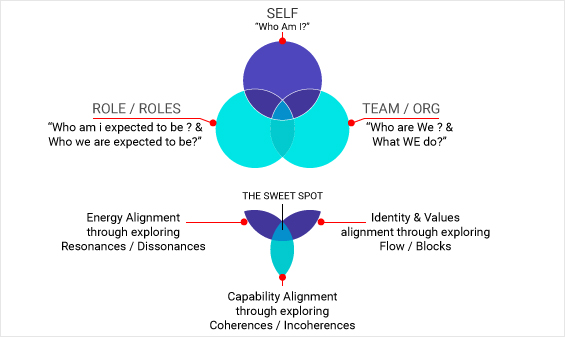The Transformative Alignment Mapper
By V.Kartikeyan, Rachna Nandakumar and Vishwanath P.
Introduction
Transformative Alignment Mapper is a product created with an intent to help leaders, organization members, and teams to plan their transformation towards higher potential by systematically helping map out transformative alignment opportunities in critical interface spaces where invisible waste can occur.
TAM is intended to be a non-psychometric and versatile tool. As an example of its versatility, the tool can be used within intact teams (Boards of Directors, Top Management Teams, Leadership Teams, Project Teams, Departmental Teams, etc), and equally for individual development within coaching and related settings.

Transformative Alignment Spaces
TAM does this using a dynamic framework spanning all the Spaces described above. Dynamic framework means that the nature of alignment can vary with time, players in the system, and changes in any one variable in the framework can and would influence changes in the others.
The figure above gives a high level visual map of the first three alignment spaces mentioned above. We will refer to this figure at other times in the course of this document. At a later stage, we will also introduce a Figure that would offer a visual map of the fourth alignment space mentioned above.
Meet our team


Background of TAM Insights
The origins of the Transformative Alignment Mapper go back to four key sources
Source 1
V.Kartikeyan’s thirty six years of learning Karnatik Music from his Guru, Padmashri N.Ramani (the celebrated flautist). Ramani taught this author the nuances and the aesthetics of music, with specfic emphasis on pitch (resonance), rhythm (coherence), flow, and listener-delight. The author sees in this, immense possibilities for organizational wholeness and effectiveness.
Source 2
The authors’ association with and learning from several Fellows of Sumedhas Academy of Human Context (www.sumedhas.org), in particular Ashok Malhotra, Raghu Ananthanarayanan, Sushanta Banerjee, Gagandeep Singh, Sarbari Gomes and Narendran KS.
Source 3
The authors’ work with Symbols (in particular, the Symbols Lab that they conduct annually for Sumedhas Academy of Human Context).
Source 4
Readings in the field of Psychology, and Organization Development (OD) named in the bibliography section.
